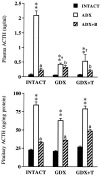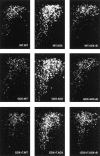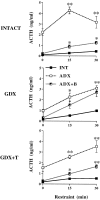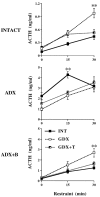Independent and overlapping effects of corticosterone and testosterone on corticotropin-releasing hormone and arginine vasopressin mRNA expression in the paraventricular nucleus of the hypothalamus and stress-induced adrenocorticotropic hormone release
- PMID: 10414997
- PMCID: PMC6782815
- DOI: 10.1523/JNEUROSCI.19-15-06684.1999
Independent and overlapping effects of corticosterone and testosterone on corticotropin-releasing hormone and arginine vasopressin mRNA expression in the paraventricular nucleus of the hypothalamus and stress-induced adrenocorticotropic hormone release
Abstract
Adrenocorticotropin (ACTH) release is regulated by both glucocorticoids and androgens; however, the precise interactions are unclear. We have controlled circulating corticosterone (B) and testosterone (T) by adrenalectomy (ADX) +/- B replacement and gonadectomy (GDX) +/- T replacement, comparing these to sham-operated groups. We hoped to reveal how and where these neuroendocrine systems interact to affect resting and stress-induced ACTH secretion. ADX responses. In gonadal-intact rats, ADX increased corticotropin-releasing factor (CRH) and vasopressin (AVP) mRNA in hypothalamic parvocellular paraventricular nuclei (PVN) and ACTH in pituitary and plasma. B restored these toward normal. GDX blocked the increase in AVP but not CRH mRNA and reduced plasma, but not pituitary ACTH in ADX rats. GDX+T restored increased AVP mRNA in ADX rats, although plasma ACTH remained decreased. Stress responses. Restraint-induced ACTH responses were elevated in ADX gonadally intact rats, and B reduced these toward normal. GDX in adrenal-intact and ADX+B rats increased ACTH responses. Without B, T did not affect ACTH; together with B, T restored ACTH responses to normal. The magnitude of ACTH responses to stress was paralleled by similar effects on the number of c-fos staining neurons in the hypophysiotropic PVN. We conclude that gonadal regulation of ACTH responses to ADX is determined by T dependent effects on AVP biosynthesis, whereas CRH biosynthesis is B-dependent. Stress-induced ACTH release is not explained by B and T interactions at the PVN, but is determined by B- and T-dependent changes in drive to PVN motorneurons.
Figures








Similar articles
-
Androgens alter corticotropin releasing hormone and arginine vasopressin mRNA within forebrain sites known to regulate activity in the hypothalamic-pituitary-adrenal axis.J Neuroendocrinol. 2001 May;13(5):442-52. doi: 10.1046/j.1365-2826.2001.00653.x. J Neuroendocrinol. 2001. PMID: 11328455
-
Immunotargeted lesions of paraventricular CRF and AVP neurons in developing rats reveal the pattern of maturation of these systems and their functional importance.J Neuroendocrinol. 1997 Jan;9(1):25-41. doi: 10.1046/j.1365-2826.1997.00544.x. J Neuroendocrinol. 1997. PMID: 9023736
-
Increased expression of corticotropin-releasing hormone and vasopressin messenger ribonucleic acid (mRNA) in the hypothalamic paraventricular nucleus during repeated stress: association with reduction in glucocorticoid receptor mRNA levels.Endocrinology. 1995 Aug;136(8):3299-309. doi: 10.1210/endo.136.8.7628364. Endocrinology. 1995. PMID: 7628364
-
The relative importance of hypothalamic neurons containing corticotropin-releasing factor or vasopressin in the regulation of adrenocorticotropic hormone secretion.Ciba Found Symp. 1992;168:43-51; discussion 51-3. doi: 10.1002/9780470514283.ch4. Ciba Found Symp. 1992. PMID: 1330458 Review.
-
Pathophysiology of massive infantile spasms: perspective on the putative role of the brain adrenal axis.Ann Neurol. 1993 Mar;33(3):231-6. doi: 10.1002/ana.410330302. Ann Neurol. 1993. PMID: 8388675 Free PMC article. Review.
Cited by
-
Neuroendocrine coupling across adolescence and the longitudinal influence of early life stress.Dev Psychobiol. 2015 Sep;57(6):688-704. doi: 10.1002/dev.21138. Epub 2013 Jun 15. Dev Psychobiol. 2015. PMID: 23775330 Free PMC article.
-
Testosterone suppression of CRH-stimulated cortisol in men.Neuropsychopharmacology. 2005 Oct;30(10):1906-12. doi: 10.1038/sj.npp.1300742. Neuropsychopharmacology. 2005. PMID: 15841103 Free PMC article. Clinical Trial.
-
A corticotropin-releasing factor receptor antagonist improves urodynamic dysfunction produced by social stress or partial bladder outlet obstruction in male rats.Am J Physiol Regul Integr Comp Physiol. 2013 Jun 1;304(11):R940-50. doi: 10.1152/ajpregu.00257.2012. Epub 2013 Apr 3. Am J Physiol Regul Integr Comp Physiol. 2013. PMID: 23552576 Free PMC article.
-
Opposing actions of adrenal androgens and glucocorticoids on alternative splicing of Slo potassium channels in bovine chromaffin cells.Proc Natl Acad Sci U S A. 2002 May 28;99(11):7722-7. doi: 10.1073/pnas.112619799. Proc Natl Acad Sci U S A. 2002. PMID: 12032350 Free PMC article.
-
Prenatal glucocorticoid exposure alters hypothalamic-pituitary-adrenal function and blood pressure in mature male guinea pigs.J Physiol. 2004 Jul 1;558(Pt 1):305-18. doi: 10.1113/jphysiol.2004.063669. Epub 2004 May 14. J Physiol. 2004. PMID: 15146051 Free PMC article.
References
-
- Abercrombie M. Estimation of nuclear populations from microtome populations from microtome sections. Anat Rec. 1946;94:239–247. - PubMed
-
- Akana SF, Dallman MF. Chronic cold in adrenalectomized, corticosterone (B)-treated rats: facilitated corticotropin responses to acute restraint emerge as B increases. Endocrinology. 1997;138:3249–3258. - PubMed
-
- Akana SF, Jacobson L, Cascio CS, Shinsako J, Dallman MF. Constant corticosterone replacement normalizes basal adrenocorticotropin (ACTH) but permits sustained ACTH hypersecretion after stress in adrenalectomized rats. Endocrinology. 1988;122:1337–1342. - PubMed
-
- Almeida OFX, Hassan AHS, Harbuz MS, Linton EA, Lightman SL. Hypothalamic corticotropin-releasing hormone and opioid peptide neurons: functional changes after adrenalectomy and/or castration. Brain Res. 1992;571:189–198. - PubMed
-
- Bhatnagar S, Dallman M. Neuroanatomical basis for facilitation of hypothalamic-pituitary-adrenal responses to a novel stressor after chronic stress. Neuroscience. 1998;84:1025–1039. - PubMed
Publication types
MeSH terms
Substances
Grants and funding
LinkOut - more resources
Full Text Sources
Miscellaneous
